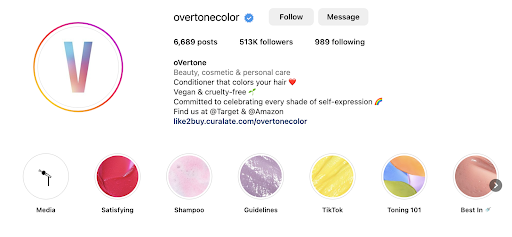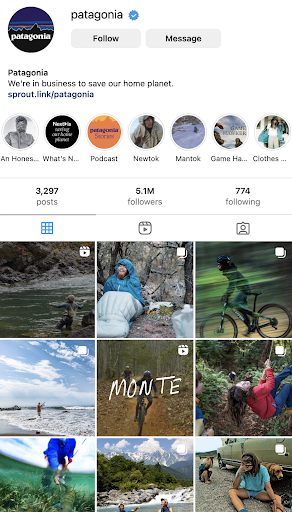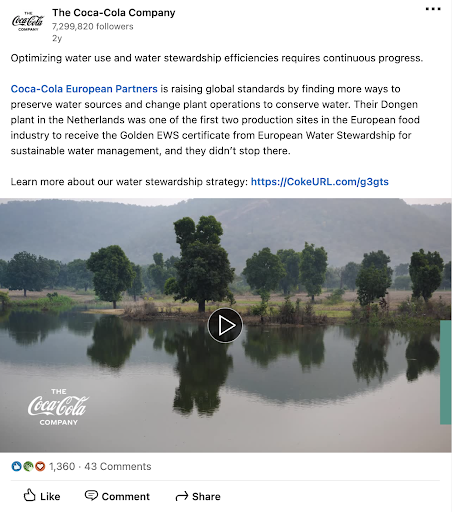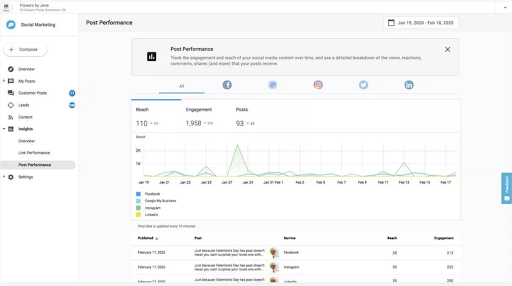The complete 16-step social media optimization checklist for marketing agencies
Social media optimization is the strategic use of social media platforms, like Instagram and LinkedIn, to manage and grow a business’s online presence, message, and revenue. It’s not just about being active on social media channels, but also about optimizing the company’s reputation and results.
Be successful with social media on behalf of your clients by downloading “The ultimate guide to effective social media for business” now.
Through a mix of social media strategies, including content creation, branding, customer engagement, and performance tracking, businesses can reach more of their target customers, drive more traffic to their websites, and generate more leads. If you’re ready to deliver industry-leading social media marketing optimization services to your clients, then this checklist is for you.
Table of Contents
- Who are you talking to? Lock down your target audience
- Say it right: Establish your brand voice
- Go undercover: Conducting competitor analysis
- Spruce up and update your social media profiles
- Plan ahead: Create a content calendar
- Consistency is key: Develop content themes
- Capture attention with engaging copy
- Seeing is believing: Incorporate visual content
- Don’t underestimate hashtags
- The art of conversation: Engage with the audience
- Understand the story data is telling you
- Timing is everything: Optimize your posting schedule
- Get the word out: cross-promote social media accounts on other platforms
- Let followers do the talking with UGC
- Iterate, iterate, iterate: Refine your social media optimization services
- Keep your finger on the pulse of what’s trending
Why is social media optimization important?
In our digitally-driven marketplace, social media optimization has become an unignorable marketing strategy for businesses of all sizes. The importance of social media optimization techniques lies in their ability to boost brand visibility, strengthen authority, and foster relationships with customers in a space where they are increasingly spending their time—nearly 2.5 hours daily (Vendasta).
Social media optimization also allows businesses to monitor and adapt to online conversations about their brand, providing a platform to amplify positive news and mitigate negative perceptions. In an era where social media impacts brand reputation significantly, social media optimization has become a powerful tool.
1. Who are you talking to? Lock down your target audience
Step one of any social media optimization strategy is to define the brand’s audience, which informs every social media decision made down the line. Launching into social media without a clear sense of who you’re trying to reach is like throwing a party and forgetting to send out invitations. Without knowing who the target audience is, you are far less likely to capture their attention.
Understanding your client’s ideal audience goes beyond general demographics like age, gender, and location. While these are undoubtedly important, diving deeper into their psychographics, behaviors, interests, and online habits can yield more actionable insights.
Are they night owls or early birds regarding social media usage? Do they prefer long-form content or quick and snappy posts? What other brands or influencers do they engage with? What are their values?
By gathering and analyzing this information, you'll be better equipped to create content that resonates, select optimal posting times, and choose the right social media platforms. With your target audience defined, you’re one step closer to making meaningful connections and driving impactful results for your clients.
2. Say it right: Establish your brand voice
Businesses have a better chance of standing out from the crowd when they have a distinct, memorable voice. The brand voice should be a unique, consistent tone and style of communicating that resonates with the target audience defined in Step 1 and amplifies the brand’s message.
Not sure how to establish a brand voice for your client? A helpful exercise is to imagine their brand as a person.
Would they be serious or playful?
Formal or casual?
Cheeky or supportive?
Duolingo is an example of a brand that leans into a cheeky, even slightly edgy, brand voice that regularly gets its audience laughing.

This voice should match the expectations of the target audience and remain consistent across all platforms. It’s worth noting that each social media platform has its own culture and norms. From a social media optimization perspective, it makes sense to respect these. However, the brand voice should still be recognizable, even if it’s adapted to be, say, more professional on LinkedIn and more conversational on Twitter.
Establishing a distinctive, recognizable, and reliable brand voice helps in strengthening brand identity, fostering trust, and most importantly, setting your client apart from the competition.
3. Go undercover: Conducting competitor analysis
Next on our social media optimization strategy checklist, we’re turning our attention to the competition.
By researching the competition’s social media strategies, you can glean valuable insights to improve your own approach. This isn’t about imitation. Instead, it’s about understanding the landscape to identify points of differentiation and capitalize on opportunities.
So, how exactly does one gather intel on the competitive landscape? Start by examining competitors’ presence across different platforms.
- What type of content are they sharing?
- What platforms do they use?
- How often do they post?
- How do they engage with their audience?
- Which posts appear to get the most engagement?
In the course of this research, pay attention to their weaknesses and strengths. Try to learn from their mistakes or shortcomings and adapt their successful strategies to your brand context. This intelligence-gathering phase can inform your own social media optimization techniques, help you avoid pitfalls, and uncover unique opportunities to interact with your audience.
4. Spruce up and update your social media profiles
Social media profiles perform multiple functions, from serving as online storefronts and doing double duty as digital business cards to providing a venue for conversations. They provide the crucial first impression of a brand to many prospective customers and act as a regular touch-point for existing customers and audiences.
That’s why optimizing these profiles is a must. A polished, consistent profile is the foundation of a business’s online identity and a cornerstone of effective social media optimization.
Pay attention to each of these components of your client’s social media profiles to make sure they support their business goals:
- Profile picture: Usually, the brand’s logo is the most appropriate profile picture, but in some cases—such as one-person service-based businesses—a portrait might be more appropriate.
- Cover photo: This should align with the brand’s image and messaging, and support the overall brand story. For example, a cafe might use the cover photo to showcase images of their farmer partners if they want to emphasize their fair-trade supply chain.
- Bio: The brand bio is necessarily short and sweet. Include a brief but complete description of the business, the unique value proposition, and maybe even a call to action (CTA) such as “Learn more here.”
- Contact details: This might include a phone number or email address, but a website link can suffice if space doesn’t allow for more.
It’s also a good idea to audit existing social media posts to make sure they align with the brand message.

5. Plan ahead: Create a content calendar
Content is the gas that keeps your social media engine running. But as anyone who has spent time managing social media for a brand can attest, staying on top of content creation—especially for multiple accounts—is a ton of work.
That’s why creating a content calendar is one of the most helpful things you can do if you offer social media marketing optimization services.
A content calendar is essentially a roadmap of what to post and when to post it. It can include a blend of curated, original, and UGC content, working together to keep audiences intrigued, entertained, and informed. This strategic planning allows businesses to maintain a consistent posting schedule, ensuring their social media presence remains active and engaging. It can also help you come up with content ideas for social media.
To create an effective content calendar, consider the preferences of your target audience identified in Step 1. What kind of content resonates with them? Then, identify key marketing dates such as holidays and product launches. When it comes to creating content, you can come up with ideas tailored to these dates, as well as more general, evergreen content to fill in the rest of the calendar.
6. Consistency is key: Develop content themes
Filling in your calendar requires developing content themes that align with your client’s brand and appeal to the target audience. Content themes are the common threads that weave through all social media posts, tying them together into a coherent and recognizable pattern that resonates with customers and fans.
To develop appropriate content themes, look at your client’s brand values, goals, and audience interests. Examples of themes might include sustainability, innovation, customer stories, or behind-the-scenes insights. These should be broad enough to provide flexibility when creating content but still maintain a clear connection to the brand and its message.

For example, a quick glance at Patagonia’s Instagram feed gives audiences an immediate idea of their content themes and message: the great outdoors, adventure, being active, and protecting the environment.
Developing consistent content themes aids in establishing a stronger brand narrative, which over time, becomes easily recognizable to the audience. The best part: it also makes content creation a more streamlined and efficient process, so you can sell more social media packages with less effort.
7. Capture attention with engaging copy
Given the visually-forward nature of many social platforms, it can be easy to overlook another key aspect of social media optimization—creating engaging copy. Writing for social media can differ from other kinds of marketing writing, with each platform lending itself to a different style.
So, how can you craft scroll-stopping copy for your clients? It’s all about enticing their audience, reflecting the brand voice, and nudging the reader towards a desired action—without being too salesy.
This starts with a deep understanding of the target audience and brand voice, which you established in earlier steps. How you can speak their language, address their needs, and stir their emotions? Top-notch social media copy also includes compelling CTAs or invitations to engagement, like “share your thoughts in the comments.”
Another key social media optimization tip to keep in mind is that engaging copy doesn’t have to be long. Sometimes, the most impactful messages are short and sweet. Not sure what kind of copy your audience prefers? Test out multiple styles and pay attention to post metrics to see what resonates most.
8. Seeing is believing: Incorporate visual content
Social media is a highly visual landscape, and nothing communicates quite as instantaneously as a powerful visual. Whether you use eye-catching images, compelling videos, or informative graphics, visual content, incorporating visuals into every social channel can help your clients stand out.

Whatever images you incorporate, be sure to stick to the brand’s aesthetic and style guide. This doesn’t mean you need to create perfectly color-graded feeds for your clients—the social media world leans more toward valuing authenticity than perfection today. But, it does mean that visual content should stick to a cohesive look that is recognizable and on-brand. This might be cheerful, relaxing, or moody, for example. All of this should be defined in a social media management guidelines document created for your client.
9. Don’t underestimate hashtags
We all remember the early days of hashtags, when posts would have dozens of irrelevant tags in an attempt to game the algorithm and appear in more people’s feeds. This spammy approach to hashtags has put some people off using this effective social media optimization tip, but incorporating them strategically can seriously boost your content’s visibility among target audiences.
Hashtags can revolve around general trends, industry-specific terms, or even unique brand campaigns. Just make sure to strike a balance: use them thoughtfully in your posts to attract new followers and increase engagement, but avoid cramming many irrelevant tags on a single post.
10. The art of conversation: Engage with the audience
What sets social media so wildly apart from traditional media is, of course, the social aspect. It allows anyone to converse with brands and businesses, fostering an environment of transparency and trust. To succeed in this environment, it’s all about fostering engagement.
A key social media optimization service is brand reputation management, and being responsive on social platforms is one of the most important activities in this area. Responding to comments and messages quickly and professionally demonstrates to audiences that the brand values their input. These ongoing interactions make audiences feel valued and heard, boosting their loyalty and affinity towards the brand.
11. Understand the story data is telling you
Social media optimization techniques are only as good as the results they produce, and the only way to understand those results is to refer to data.
Figures such as likes, shares, comments, and reach are more than numbers—they’re insights into what resonates with the target audience. By tracking these metrics, you can get a deeper understanding of your audience’s preferences, allowing you to adjust your strategy and create more impactful content.

Optimization means constant refinement. Trends shift, behaviors evolve, and staying on top of your social media analytics ensures you can change course as needed, always delivering content that drives results.
12. Timing is everything: Optimize your posting schedule
Sometimes, social media optimization is all about being in the right place at the right time. You need to figure out when your audience is most active and likely to engage with your content, otherwise, even the most well-thought-out post can be forgotten by the algorithm and fall flat.
This might require some trial and error, and that’s okay. Experiment with different times and observe the engagement levels. Remember, people’s online habits change, and staying flexible allows you to find the rhythm that gets your content seen and appreciated by the widest audience possible.
The best social media optimization tools, like Vendasta’s Social Marketing, include in-app features that help you gauge the ideal time to post based on your audience’s behavior.
13. Get the word out: cross-promote social media accounts on other platforms
Even devoted fans of a brand might forget to follow along on social media, so it’s crucial to give audiences on other platforms a nudge to follow along. For example, your client’s website should have links to social media profiles in the footer and wherever else it’s appropriate.
Don’t hesitate to include those links in email signatures, newsletters, and across platforms—for example, linking to their Instagram account in their LinkedIn bio. Every single follower is a potential customer and brand ambassador. The more visibility a brand has, the larger its audience, and the greater the opportunities for conversion. Don’t be shy about promoting all active social media accounts to maximize visibility.
14. Let followers do the talking with UGC
When it comes to building trust and authenticity, user-generated content (UGC) is the gold standard. This is content created by a brand’s audience, showcasing their experiences and views about a product or service. It can come in the form of reviews, photos, videos, social media posts, blog posts, or just about any other social content created by a customer.
By leveraging UGC, you can enhance the variety of content on your client’s feeds and demonstrate that real people value and enjoy their offerings. Plus, featuring UGC sends a clear message to the audience that their voice matters, their experience is valued, and their contribution is appreciated. It’s the perfect way to establish social proof and build a sense of community around a brand.

15. Iterate, iterate, iterate: Refine your social media optimization services
In a field as rapidly changing as social media, standing still is as good as moving backward. The only way to keep up with changing algorithms and trends is to adopt an iterative approach.
To do this, regularly evaluate your social media optimization techniques, checking in with your analytics and gauging the effectiveness of your efforts.
- Are your posts hitting the mark?
- Is your engagement growing?
- Are your key performance indicators (KPIs) benign met?
If not, don't be afraid to reassess and make tweaks. Maybe it’s time to shake up your content themes, or perhaps your posting schedule needs an overhaul. Continuous refinement keeps your strategy fresh, your audience engaged, and ensures your social media marketing optimization services continue to support your client’s broader business goals.
16. Keep your finger on the pulse of what’s trending
You may not want to be a trend-chaser IRL, but when it comes to social media, being trend-conscious is a good thing. New platforms, algorithm changes, and innovative content formats pop up constantly, and what worked last month may not be as effective today.
Come up with a system for staying on top of these new developments. Subscribe to influential newsletters, attend webinars, and soak up wisdom from thought leaders in the industry. Spending some time on social media each day is another way to organically get a feel for trends as they emerge.
If keeping up with the latest trends would take more time than you have to spare, using white-label social media service providers can help you deliver industry-leading services—without the in-house time and labor.
Frequently asked questions
Should I focus on organic social media optimization or paid social media advertising?
Organic social media optimization and paid social media advertising should both be part of a balanced social media strategy. Organic efforts build a solid foundation and foster meaningful relationships with your audience. Meanwhile, paid advertising amplifies your reach and targets specific segments more effectively. Consider them as complementary strategies: organic efforts nurture and engage your audience base, while paid strategies drive growth and visibility.
What are some tools and resources available for social media optimization?
Various tools and resources can support social media optimization. Social media management tools Vendasta’s Social Marketing schedule posts, monitor engagement, and track analytics. Canva offers design resources for creating eye-catching visuals even if you don’t have graphic design experience. A range of free and paid tools are available to help users identify trending hashtags.
[adrotate banner="266"]

